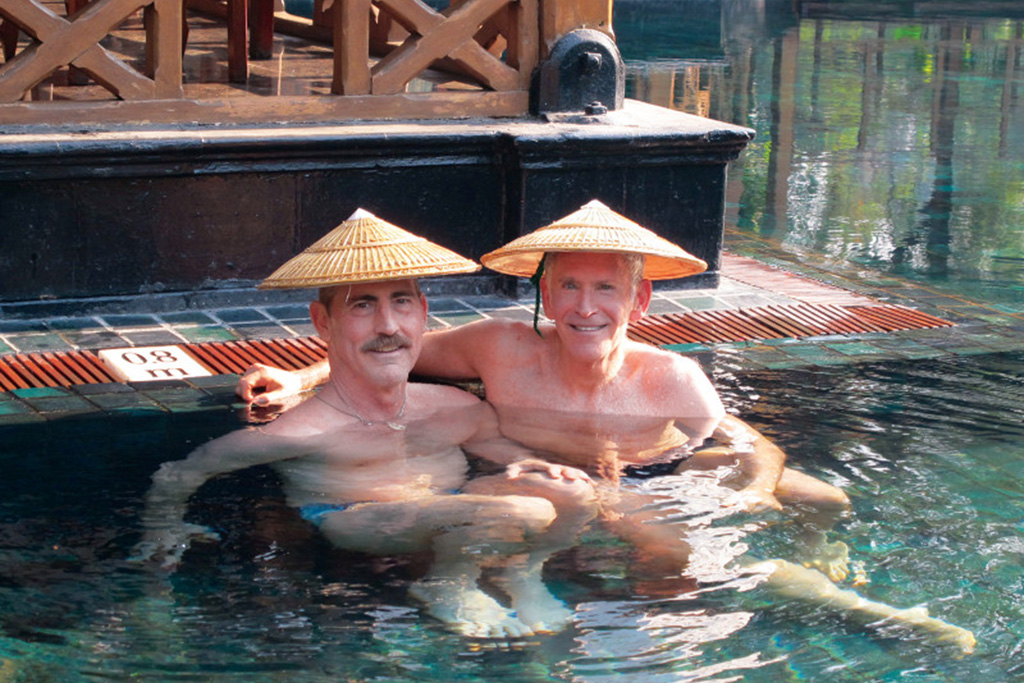After the market, we embark in the boat and follow a network of river inlets and canals, threading through narrow sluice gates in bamboo dams, and under bamboo bridges spanning the waterways. We dock in a bend of a river in the center of a village and hike a short distance to dozens of pagoda ruins, constructed by the Pa-O people hundreds of years ago. The vegetation has all but consumed them, weeds sprouting from the ornate stone lintels, a banyan tree shattering a pagoda wall.
The next day, Peter and I rent bicycles ($2 per day) to explore the lake perimeter’s sights: hot springs, cottage industries, vineyards. We peddle west from Nyuang Shwe through farmland along a bumpy road where gangs of young women labor hauling rock and gravel for road improvements. It is hot, and at a well near a temple, I haul up a bucket of water and pour it over my head. Five miles farther south, we reach the hot springs offering several soaking pools; gender-mixed and sex-segregated ones. It cost all of $5 to relax before we set off again.
A mile southward, we reach Aung Daing, an Intha village producing Shan state’s famous tofu, created from yellow lentil flour that is made by vigorously stirring the boiling flour, then setting it in molds. After a lunch of tofu thoke (tofu salad made from tofu wafers set out to dry), we hire a boat to ferry us with our bikes across the lake where we cycle north past villages and sugar cane plantations.
Surprisingly, a new wine industry has sprung up around Inle Lake, and we pedaled up the hill to Red Mountain Winery for a magnificent view of Inle and the vineyards. Wine tasting costs a couple of dollars, and Red Mountain’s pinot noir and sauvignon blanc are favored varietals.
MANDALAY
Initially we thought to skip Mandalay altogether, afraid it would be another chaotic, urban jungle (note that it isn’t), but when we enter our room at the Hotel Sedona Mandalay, we immediately change our minds. The fifth-floor room is perfectly situated at the northeast corner of the hotel with a sweeping view of the moat surrounding Mandalay Palace to Mandalay Hill. The palace’s crenelated stone walls are punctuated with pyramid towers of intricately carved wood.

We only have an hour before closing to wander through the palace grounds, a complex of teak buildings constructed in the mid-1800s for the king and his numerous wives. After the British exiled the family to India, they demolished part of the palace, and commandeered the multi-layered gilt filigree throne room as an officer’s club. Sadly, everything was incinerated by WWII bombings by the Japanese, but the center piece, a peculiar spiral watchtower, was rebuilt. The remaining 2.4-square-mile grounds are an out-of-bounds military encampment.
Later, we hail a taxi (walking would have taken an hour) and make it in time up Mandalay Hill to a temple guarded by two giant chinthe (lion-dog creatures) for sunset—another tourist must. Here, the halls are covered in brilliant glass and mirror mosaics, reflecting the impressive sunset.
The next day, we visit one of the numerous gold-pounding workshops. An ounce of gold is flattened, then cut into pieces, layered between thin paper made from bamboo (how the incredibly durable bamboo paper is made is just as interesting as the gold leaf), that’s hammered for hours by muscular young men, then the process repeated until that original blot of gold becomes over 3000 thin squares.
Frankly, I’d never given a thought to how gold leaf was made, and it was fascinating and free, though I do buy a packet to bring to the Mahamuni Paya. The centerpiece of this massive temple complex is a 13-foot seated Buddha. Thousands of faithful, including children dressed in colorful coming-of-age costumes, thronged about while I wait in the line of pilgrims, and eventually ascend the steps to apply my gold leaf to the body of the Buddha. Over the centuries the votary gold has accumulated in knobs six-inches thick; except for on his gleaming, polished beneficent face.
The following morning as we drive south to Bagan, we stop at one of Burma’s most iconic and photographed sites, the mile long U Bein Bridge, constructed entirely of teak and traversing the shallow Taungthaman Lake. The prime time to visit is at sunrise when hundreds of villagers and monks commute back and forth across the bridge, the misty light making for fantastic photos.


